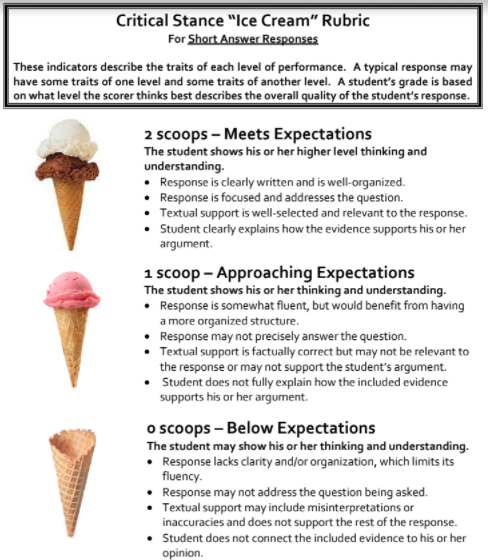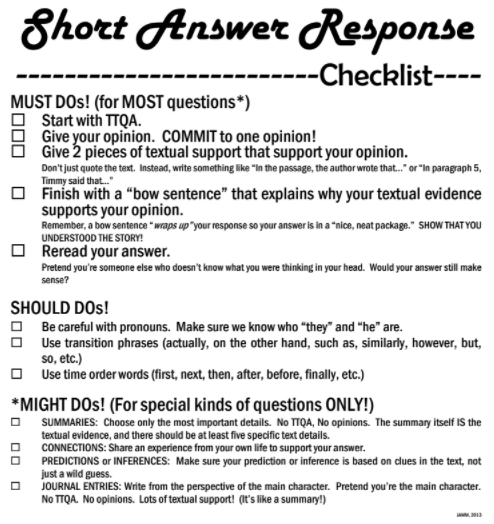Viewing: November, 2017
November 9, 2017
How Written Responses are Assessed
With report cards coming home in about a week, I wanted to take a moment to encourage you to visit your child’s Google Classroom page. You’ll need to login with his or her username and password, but the students know that she should always be willing to share their login information with their parents/guardians. On our Google Classroom page, you’ll find much of your child’s written work, including responses to text (check out “A Chair for My Mother SAR”) and descriptive writing (look for the “Summer Snapshot” writing) projects. Feel free to look around, but PLEASE allow your child to do his or her work at school, and please resist the strong urge (Hey, I get it!) to help your child to improve the works-in-progress you see (since I won’t know what’s your child’s work and what is your work).
While not all the documents you’ll come across are intended to be graded (as some are planning tools for other purposes, others are collaborative practice, etc.), those tasks that are assessed are graded within the document itself. Any grades and comments are written in yellow text, highlighted in black. Bold as that is, it clearly distinguishes my work from your child’s work. (Think of that color pattern as my trademark “teacher’s red pen”, if you will.)
 Short answer responses are most typically assessed on a 0-1-2 point scale. Here is a copy of the rubric we use. I want to stress that 0, 1, and 2 should not be converted into a percentage. That is, I’d hate for you to think a score of 1/2 is the same as 50% (a failing grade) or that 2/2 is 100% (perfection). Rather, a 2/2 is a proficient response that includes all the elements I am looking to see. Could it potentially be improved? Of course! A 2/2 doesn’t mean that it’s perfect, just that it met expectations. Likewise, a 1/2 isn’t a failing grade. It means that the student is well on his or her way to developing a successful response, but he or she needs to improve one or more parts of the response in order to reach a 2. When I give a 1, I find myself most often asking students to give more textual support, to select more appropriate textual support, or to focus their response on a single idea and develop that idea more thoroughly. You’ll always see comments from me to explain why your child received the score he or she did.
Short answer responses are most typically assessed on a 0-1-2 point scale. Here is a copy of the rubric we use. I want to stress that 0, 1, and 2 should not be converted into a percentage. That is, I’d hate for you to think a score of 1/2 is the same as 50% (a failing grade) or that 2/2 is 100% (perfection). Rather, a 2/2 is a proficient response that includes all the elements I am looking to see. Could it potentially be improved? Of course! A 2/2 doesn’t mean that it’s perfect, just that it met expectations. Likewise, a 1/2 isn’t a failing grade. It means that the student is well on his or her way to developing a successful response, but he or she needs to improve one or more parts of the response in order to reach a 2. When I give a 1, I find myself most often asking students to give more textual support, to select more appropriate textual support, or to focus their response on a single idea and develop that idea more thoroughly. You’ll always see comments from me to explain why your child received the score he or she did.
How does your child know what goes into a 2/2 response? Good question! In our class, we use a short answer response (SAR) checklist to help students know what a thorough response looks like. Pictured to the right, this checklist lets students organize their writing. Your child should be able to explain to you what things like TTQA and “bow sentences” are.
Other areas, such as organization, sentence structure, grammar, capitalization and punctuation, and spelling are assessed using our report card scale: EMAB. A score of M is most common, indicating that a student is meeting grade-level expectations. An E means that a student has exceeded my grade level expectations. It’s important for you to understand that I don’t look at an M as falling short of earning an E, even though many families tend to feel this way. When a student’s work goes above and beyond and shows a particularly sophisticated application of the concept or skill, he or she may earn an E. Parents often ask “What does my child need to do to earn an E?” That’s really hard to answer. Allow me to provide an example. Imagine a student wrote the following description of our classroom:
There are homemade posters, called anchor charts, hanging all over from lessons. They help us to remember what Mr. Moss taught us. There are also book boxes that alternate in color between yellow and green. These hold all the great books that we get from our class library, school library, or from home. The colorful paper lanterns add even more color to our classroom.
That was a perfectly good description of our classroom, and if I was assessing the response’s sentence structure, it would earn an M. Now compare it to this response:
In our classroom, homemade posters hang all over. Called anchor charts, these tools help us to remember what Mr. Moss has taught us. The yellow and green book boxes add a splash of color to the room, as do the hanging colorful paper lanterns.
It’s clear that this second passage is a more sophisticated style of writing, and it’s sentence structure grade would be an E. But if a parent were to ask me what their student (writer of the first response) needs to do to improve, I’d have a hard time explaining it. The growth comes naturally, as a student becomes a more mature writer. As their overall use of the written English language matures, so will these discrete sentences. It’s the same with word choice. I’d hate for a parent of a student earning an M for word choice to have their child study new vocabulary words with the specific goal of earning a better grade. Instead, as the child reads more mature books with more mature word choices, it’s reasonable to expect that their lexicon will continue to grow and develop.
A grade of A means that a child is approaching the goal, is continuing to work to develop his or her skills in a given area, and has more work to do before reaching goal. An A isn’t a disaster. While I do want to avoid seeing too many A’s in a student’s work, it can serve as a focus area for your child (and perhaps for you, as you work to support your child). Finally a B means that your child’s work is below expectations and that he or she has plenty of room to grow.
I look forward to answering any of your questions about this when we meet for parent-teacher conferences. But in anticipation of our upcoming conversation, please take a moment to look at your child’s Google Classroom page so you are best informed of his or her progress in class.
Posted in Class Updates|By Jon Moss

